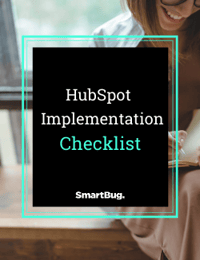
Is this scenario familiar to you? You’ve heard about everything HubSpot can do, and like a tween bugging their parents for a must-have video game, you can’t help but be giddy at the possibilities. If you’re struggling to make the most of your Marketo account, your desire to move to HubSpot can feel even more prevalent—and more desperate. Many marketers have found success with HubSpot after migrating, wondering why they didn’t do so sooner.
However, some companies are better off staying with Marketo. The platform just works better for them and offers benefits that HubSpot can’t. Furthermore, migrating is more than a quick installation and a brief setup. The transition takes planning, time, and dedication. Here are some things you need to know before deciding to make the switch.
Why Switch?
As far as marketing automation platforms go, Marketo is no slouch. It delivers efficiency, scalability, analytics, Salesforce integration, and other features crucial to modern digital marketing. So why switch to HubSpot, which offers these same features? Some reasons include:
HubSpot May Be Cheaper
For many similar features and functionalities, HubSpot can prove to be a less expensive option than Marketo. The price will vary depending on features and database size. Use HubSpot’s calculator to get an idea if HubSpot will actually be cheaper.
HubSpot Is All-Inclusive
Expanding Marketo often requires add-ons, plug-ins, modules, and other programs to introduce into the platform. HubSpot already comes with features such as its own CRM and a CMS. Although that doesn’t prevent you from using another platform like WordPress, for example, you can do almost anything within HubSpot from day one.
HubSpot Is Easier to Use
Not only is HubSpot loaded with functionality, but it also is more user-friendly than Marketo. Point, click, and type—HubSpot is so easy that non-marketers don’t need much advanced training to navigate around the platform and use its features to the fullest.
Marketo Might Be ... Too Much
For larger businesses, Marketo is a robust platform with practically unlimited scalability. For smaller businesses, Marketo can almost be overkill—companies choose it, then soon discover it’s more than they need and more than they can manage. That doesn’t necessarily mean that SMBs can’t use and benefit from Marketo or that HubSpot isn’t good for larger businesses. It just reveals that if Marketo seems too overwhelming, HubSpot might be the simpler option that delivers the same high level of marketing automation.
Before making a switch from Marketo to HubSpot, companies and marketing teams should consider if they really will benefit from such a move. If you’re fully invested in Marketo and have devoted significant budget toward the platform, starting over might be wasteful. Furthermore, you just can’t flip a switch and transfer all your existing marketing to HubSpot. Carefully consider our migration advice before pulling the trigger on ditching Marketo.
Rebuilding Takes Time
Although HubSpot offers some out-of-the-box functionality, migrating from Marketo isn’t as smooth and quick as, for comparison’s sake, moving data from one smartphone to another. Implementation takes time. The transfer of leads takes time. Setting up campaigns and workflows takes time. Training on the new system takes time. Thinking this can all be accomplished in a month, for instance, is a recipe for disaster.
A bigger concern is if your Marketo contract is expiring and you’re planning a migration to HubSpot, but you haven’t allowed yourself the time necessary to make the move. If you aren’t ready with the new platform when your Marketo contract expires, you’ll be stuck in marketing limbo.
Plan far ahead (at least a couple of months) for the migration, and if you calculate that you can’t get everything done in time, don’t force it. You’ll be better off sticking with Marketo. HubSpot isn’t going anywhere, and you can make the move when you’re ready.
Migration Costs
In some cases, HubSpot is a more economical choice, but you might find the actual migration prohibitively expensive. Human resources must be devoted to making the move, and if you’re already busy, that requires overtime or outsourcing to complete the migration. Your Marketo and HubSpot contracts may also overlap, which can strain your budget. Any downtime that occurs presents a potential short-term cost as well. The marketing you miss as you’re getting up to speed might lead to weaker reporting numbers a few weeks down the road.
Of course, migrating to HubSpot is a long-term decision, but the immediate costs can’t be ignored. Calculate ROI and determine if you can swing the up-front costs and derive enough value later on.
Transferring Leads
Moving leads from Marketo to HubSpot presents a unique migration challenge. There’s no magic number on how many leads are too many to seamlessly make the move, but once you reach a six-digit number of contacts, the transfer becomes more laborious.
Another concern lies in purposely having leads in either Marketo or Salesforce—for example, if you don’t want leads in Salesforce until they’re sales qualified leads (SQLs)—or records in both platforms that don’t exactly match up. More time and care will be needed to ensure everything moves over and no contact is left behind.
Plan on Training
HubSpot is easy to use and provides plenty of resources to learn the platform and inbound marketing. However, that training is still so necessary to understand the ins and outs of the software. For starters, the terminology is different. For example, an engagement in Marketo is a workflow in HubSpot. If you’re used to blogging in WordPress, the HubSpot CMS might feel a little weird at first. And marketing tools that you weren’t using in Marketo may require some practical learning to take advantage of in HubSpot.
Therefore, you should set aside time for training, preferably before you officially make the switch. You still may be a little slow-footed at the start, but at least you won’t be completely lost when you’re using only HubSpot.
Think About Using an Agency
For some businesses, trusting an outside marketing agency to handle the nuts and bolts of a Marketo-to-HubSpot migration is more cost-effective and much more successful than attempting it on their own. Plus, the migration itself may seem daunting—so much so that you might not even consider HubSpot out of fear of resources required or that you might screw it up.
A great agency becomes a partner during the migration, not only helping with the technical stuff, but also providing guidance, advice, and strategy along the way. HubSpot offers concrete advantages for marketing teams willing to make the switch. An agency can help you realize those advantages sooner.

About the author
Danielle Langenderfer was formerly a Marketing Automation Manager based in Cleveland, OH. Dani provided Marketo expertise and support in everything from implementation through to strategy and execution. Outside of work, you can find Dani playing with her daughter, crafting, or cooking/baking. Read more articles by Danielle Langenderfer.








-2.png?width=800&length=800&name=Blog%20header%20image%20(1)-2.png)